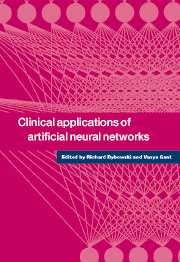Book contents
- Frontmatter
- Contents
- List of contributors
- 1 Introduction
- Part I Applications
- 2 Artificial neural networks in laboratory medicine
- 3 Using artificial neural networks to screen cervical smears: how new technology enhances health care
- 4 Neural network analysis of sleep disorders
- 5 Artificial neural networks for neonatal intensive care
- 6 Artificial neural networks in urology: applications, feature extraction and user implementations
- 7 Artificial neural networks as a tool for whole organism fingerprinting in bacterial taxonomy
- Part II Prospects
- Part III Theory
- Part IV Ethics and clinical prospects
- Index
4 - Neural network analysis of sleep disorders
Published online by Cambridge University Press: 06 October 2009
- Frontmatter
- Contents
- List of contributors
- 1 Introduction
- Part I Applications
- 2 Artificial neural networks in laboratory medicine
- 3 Using artificial neural networks to screen cervical smears: how new technology enhances health care
- 4 Neural network analysis of sleep disorders
- 5 Artificial neural networks for neonatal intensive care
- 6 Artificial neural networks in urology: applications, feature extraction and user implementations
- 7 Artificial neural networks as a tool for whole organism fingerprinting in bacterial taxonomy
- Part II Prospects
- Part III Theory
- Part IV Ethics and clinical prospects
- Index
Summary
Introduction
It is well known that quality of life is critically dependent on quality of sleep. Consequently, the evaluation of sleep disorders is one of the fastest growing sectors of US and European health care. Patients suffering from sleep disorders or excessive daytime sleepiness are referred to sleep laboratories. In these laboratories, sleep is monitored continuously for a whole night using the electroencephalogram (EEG) recorded from the scalp, the electro-oculogram (EOG), the chin electromyogram (EMG) and other physiological signals. There is a need for an automated analysis system to identify anomalies in the sleep patterns (primarily from the EEG) and help to decide on possible therapeutic measures. The standard method for analysing the EEG during sleep is a rule-based system (Rechtschaffen & Kales 1968) developed 30 years ago, which assigns consecutive 30-second segments uniquely to one of six categories (wakefulness, dreaming sleep or rapid eye movement (REM) sleep, and four stages of progressively deeper sleep, stages 1 to 4). The rules, however, are notoriously difficult to apply and inter-observer correlation can be as low as 51% in the classification of intermediate stages (Kelley et al. 1985). The lack of agreement amongst trained human experts has made the automation of the rule-based ‘sleep scoring’ process a very difficult task.
A problem such as this presents an ideal application domain for neural networks. We have developed an approach for the analysis of the sleep EEG that combines both unsupervised and supervised learning.
Information
- Type
- Chapter
- Information
- Clinical Applications of Artificial Neural Networks , pp. 90 - 101Publisher: Cambridge University PressPrint publication year: 2001
Accessibility standard: Unknown
Why this information is here
This section outlines the accessibility features of this content - including support for screen readers, full keyboard navigation and high-contrast display options. This may not be relevant for you.Accessibility Information
- 1
- Cited by
